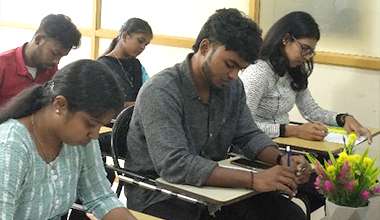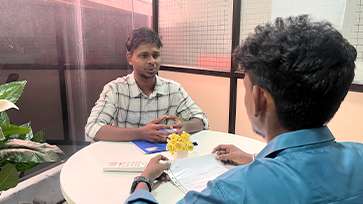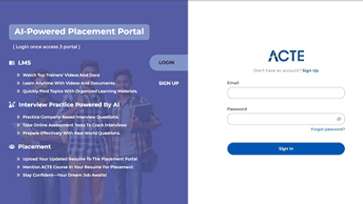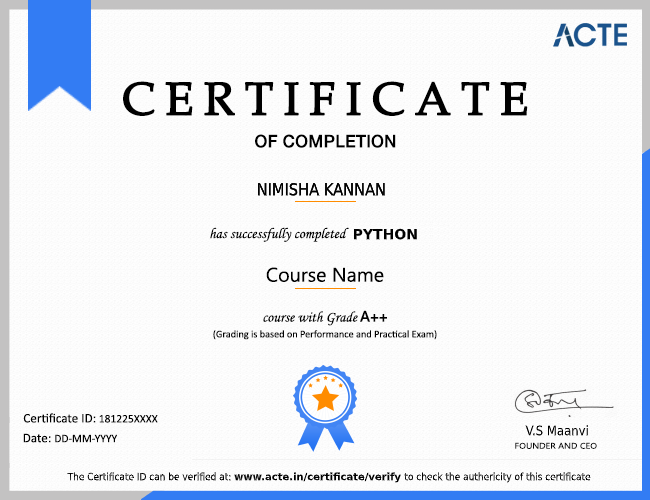Additional Info
Why You Choose BlockChain
“The blockchain ledger contributes to transaction transparency. Allows the end-user to engage directly with the ledger by eliminating middlemen. Reduces the cost of sending value and money throughout the world for pennies on the dollar. Transactions are nearly instantaneous, safe, and transnational. The demand for Blockchain jobs is rising due to the high pay: Because Blockchain is a new sector with limited expertise, the compensation given for both technical and non-technical roles is significantly greater than for other types of occupations. Furthermore, the income sharing mechanisms in Blockchain jobs are considerably better, and the incentives are therefore much higher.
Remote working flexibility : Remote employment is on the increase these days, and individuals are increasingly eschewing the notion of an office in favor of location freedom. This is one of the reasons why Blockchain firms outperform their rivals. Crypto firms can provide work-from-home opportunities, with only a few days in the office required. Staff liquidity is an advantage available solely to token businesses. Most startup employees receive stock and must wait for a liquidity event to sell their shares and receive money. This is a difficult procedure, and most grants are quite restricted, effectively blocking secondary business. In Blockchain firms, however, employees are given a token that acts as a form of equity remuneration. In turn, these tokens are inborn liquid shares.
Key Concepts of BlockChain :
Simply said, blockchain technology is a decentralized, distributed ledger that tracks the origin of digital assets. The data on a blockchain can't be changed by design, making it a genuine disruptor in areas like payments, cybersecurity, and healthcare. Our expert will explain what it is, how it is used, and its history. Through the use of decentralization and cryptographic hashing, blockchain, also known as Distributed Ledger Technology (DLT), makes the history of any digital asset unalterable and visible. A Google Doc is a good comparison for understanding blockchain technology. When we produce a document and share it with a group of individuals, instead of being duplicated or transferred, the document is disseminated. This establishes a decentralized distribution network in which everyone has simultaneous access to the document. No one is locked out while waiting for another party to make changes, and all changes to the document are logged in real-time, making them transparent.
Of course, blockchain is more sophisticated than a Google Doc, but the comparison is useful because it highlights three key concepts :
- A blockchain is a database that holds encrypted data blocks and links them together to establish a chronological single-source of truth for the information.
- Instead of being duplicated or moved, digital assets are distributed, establishing an immutable record of the asset.
- The asset is decentralized, providing public access in real-time and transparency.
- The integrity of the document is preserved via a visible record of modifications, which builds trust in the asset.
- The inherent security features of blockchain, as well as its public ledger, make it an ideal solution for nearly any industry.
Blockchain is a particularly promising and revolutionary technology since it reduces risk, eliminates fraud, and provides transparency in a scalable manner for a wide range of applications.
Every chain is made up of many blocks, each of which contains three fundamental elements:
- The information contained in the block.
- A nonce is a 32-bit whole number. When a block is formed, a nonce is generated at random, which then creates a block header hash.
- The hash is a 256-bit integer that is associated with the nonce.
A nonce creates the cryptographic hash when the first block of a chain is produced. Unless it is mined, the data in the block is regarded as signed and eternally linked to the nonce and hash.Miners use a technique called mining to add new blocks to the chain. Every block in a blockchain has its unique nonce and hash, but it also refers to the hash of the preceding block in the chain, making mining a block difficult, particularly on big chains. Miners utilize specialized software to solve the very difficult arithmetic issue of generating an approved hash using a nonce. Because the nonce is only 32 bits long and the hash is 256 bits long, there are about four billion nonce-hash combinations to mine before finding the proper one.
Modifying any block earlier in the chain necessitates re-mining not only the affected block but all subsequent blocks as well. This is why manipulating blockchain technology is so tough. Consider it "safety in arithmetic," because discovering golden nonces takes a long time and a lot of computer resources. When a block is successfully mined, all nodes in the network acknowledge the change, and the miner is paid monetarily.
Roles & Responsibilities :
1. The Different Types of Blockchain Developers :
- Blockchain Developers at the Core
- Developers of Blockchain Software, The architecture of a blockchain system, how its protocols should be built, the design of the consensus protocol, and other high-level choices and development relating to blockchain technology are primarily the responsibility of core blockchain developers. Blockchain software developers, on the other hand, construct decentralized apps that operate on blockchain technology using the architecture and protocols defined by Core Blockchain developers.
2. The Functions of a Blockchain Developer :
A core blockchain developer, as previously said, is typically engaged in the design, architecture, and security of a blockchain system. In a nutshell, their responsibilities are as follows:
- Blockchain protocol design
- Design of network consensus protocols and security patterns
- The network architecture is designed.
- The entire network is under supervision.
3. Developer of Blockchain Software :
Developers of blockchain software have their own set of responsibilities. These responsibilities have nothing to do with the system's consensus design or architecture. To construct web apps, a regular web developer follows the protocols and design structure established by a core web architect. Decentralized applications, or Dapps, are created utilizing blockchain technology by blockchain software developers. Their roles include :
- Smart Contracts Development
- Development of Dapps' interactive front-end designs
- Blockchain-related backend development
- Oversight over the complete stack that runs their Dapps
Required Skill :
To become a blockchain developer, you'll need the following technical skills.When it comes to a blockchain developer, a diverse set of abilities is anticipated. Let's take a look at each one separately.
- The architecture of the Blockchain :
Cryptographic hash functions, consensus, and distributed ledger technologies should all be familiar to them. Reading the bitcoin blockchain whitepaper is the best approach to become familiar with blockchain technology. However, reading the entire white paper can be time-consuming, and some advice can always help to shorten the learning curve. As a result, you might enroll in Edureka's Blockchain course.
- Structures of Data :
Second, aspiring to be a blockchain developer necessitates a thorough understanding and practical understanding of data structures. To fulfill their own network needs, blockchain developers are continuously experimenting with and altering existing data structures like Merkle trees and Patricia trees. Blockchain creates a safe and immutable system by combining a variety of data formats with strong cryptography. Knowledge of blockchain can only be considered incomplete if it is not accompanied by an understanding of data structures.
- Cryptography :
Because blockchain is a combination of data structures and advanced encryption, it goes without saying that a solid understanding of cryptography is also necessary to work as a blockchain developer. Aside from asynchronous cryptography for creating digital signatures, blockchain uses a variety of cryptographic methods such as hash functions such as SHA256 and KECCAK256. It is difficult to become a blockchain developer without first knowing how they function.
- Development of Smart Contracts :
Since the introduction of Ethereum, smart contracts have grown in popularity. Every blockchain is now attempting to include smart contract capabilities into its system, allowing business logic to be applied to the blockchain with ease. As a result, developers interested in working in the blockchain area should learn about smart contract programming. This usually requires learning network-specific programming languages such as Solidity, Viper, Chaincode, and so on.
- Web-Development :
A blockchain developer's main skill is web development. When a blockchain developer first starts in the business, the bulk of them is responsible for the fundamental design of decentralized apps. This implies you should be familiar with the fundamentals of both front-end and back-end programming, such as developing interactive graphical user interfaces for Dapps, API management, and request processing, among other things.
- Blockchain Developers are being hired by businesses :
If you think you have what it takes to be a blockchain developer, now is a great moment to do so since chances abound. In the blockchain developer sector, one out of every five jobs is connected to technology. There is just one blockchain developer who qualifies. Many Fortune 500 organizations are looking for qualified blockchain developers, including IBM, Accenture, and Capgemini.
Benefits :
1. Improved Transparency :
One of the major challenges in the present industry is transparency. Organizations have attempted to establish additional rules and laws to increase openness. However, there is one factor that prevents any system from being completely transparent: centralization.An organisation may use blockchain to create a completely decentralised network that eliminates the need for a centralised authority, increasing the system's transparency.
A blockchain is made up of peers that are accountable for carrying out and validating transactions. Although not every peer participates in the consensus approach, they have the option of participating in the validation process.The consensus technique is used to offer validation through decentralisation. Each node retains a copy of the transaction record once it has been verified. The blockchain network handles transparency in this way.When it comes to organisations, transparency has a greater impact. Governments may use openness to construct government procedures and even conduct voting, as previously noted.
2. Increased Security :
In comparison to previous platforms or record-keeping methods, blockchain technology employs improved security. The consensus technique must be used to agree on any transactions that are ever recorded. Each transaction is also encrypted and includes a hashing algorithm to relate it to the previous one.The fact that each node has a copy of all transactions ever completed on the network adds to the security. As a result, any malicious actor attempting to modify the transaction will be unable to do so because other nodes would deny his request to post transactions to the network.
Blockchain networks are also immutable, which means that data can't be changed once it's been written. This is also the best option for systems that rely on immutable data, such as citizen-ageing systems.
3. Cost Savings :
Businesses are currently spending a lot of money to enhance their present system's management. That is why they seek to save costs and invest the savings in something new or bettering existing operations.Organizations may save a lot of money by adopting blockchain to reduce costs connected with third-party providers. There are no vendor charges on blockchain since there is no inherited centralised actor. Furthermore, when it comes to verifying a transaction, there is less contact required, reducing the need to spend money or time on mundane tasks.
4. Authentic Traceability :
Companies may use blockchain to focus on building a supply chain that includes both vendors and suppliers. It is difficult to trace products in the traditional supply chain, which can lead to a variety of issues such as theft, counterfeiting, and product loss.
The supply chain becomes more visible than ever before thanks to blockchain. It allows all parties in the supply chain to track the items and verify that they are not being replaced or abused. Companies can also benefit from blockchain traceability by deploying it inside.
5. Improved Speed and Efficiencies :
The final industrial benefit provided by blockchain is increased efficiency and speed. Blockchain automates time-consuming processes to increase efficiency. With the assistance of automation, it also eliminates human mistakes.By providing a single location to store transactions, the digital ledger makes all of this feasible. Everything becomes very efficient and quick as a result of process simplification and automation.
Framework
- Hyperledger is one of the best frameworks for blockchain apps.
- Corda is an open-source framework that debuted in 2016. The R3 CEV collaboration developed this architecture.
- Quorum. JPMorgan created an open-source platform.
- Ethereum. The cryptocurrency industry's initial platform is Ethereum.
- Exonum, exonum, exonum, exonum, exonum
- Openchain.
- MultiChain.
Certification :
A Certified Blockchain Expert is a professional who has a thorough understanding of Blockchain technology and can create Blockchain-based business applications. CBE is a comprehensive training programme that culminates in an exam-based Blockchain certification that aims to provide in-depth practical understanding of Blockchain technology.
Pay Scale :
In India, the pay for Blockchain Developers is rather high. As more Indian businesses and organisations jump on board the Blockchain bandwagon, the average yearly pay of a Blockchain Developer in India is becoming more diverse. A Blockchain Developer's pay in India typically varies from Rs. 500k to Rs. 300K LPA.































